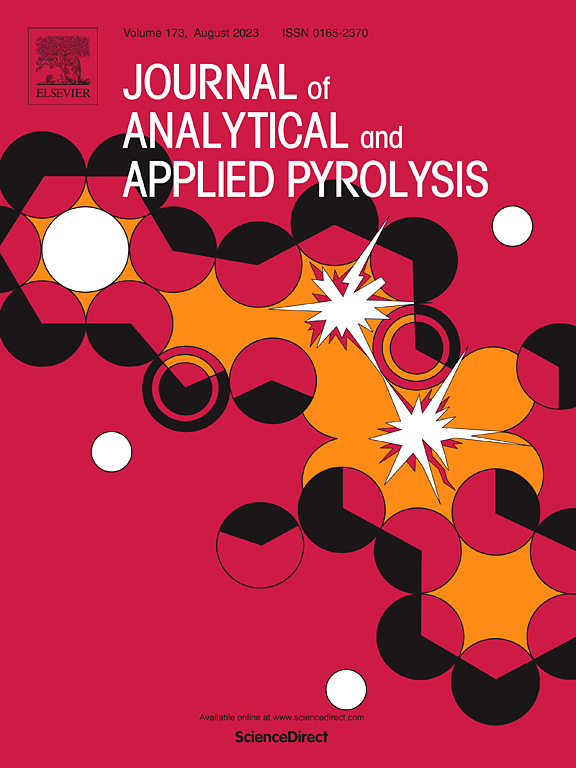废轮胎和玉米秸秆的共热解活化和协同作用:动力学、热力学属性、驱动因素和污染物减少机制途径的详细研究
IF 6.2
2区 化学
Q1 CHEMISTRY, ANALYTICAL
引用次数: 0
摘要
废轮胎(WT)热解是一种众所周知的生产燃料的技术,但由于硫、氮和几种添加剂的存在,不可避免地会形成多环芳烃、s化合物和n化合物等污染物。废轮胎与生物质共热解是一种抑制污染物、缓解环境问题的可行方案。因此,利用TG-MS和Py-GCMS对废轮胎和玉米秸秆(CPS)进行共热解,考察其协同效应。CPS的加入提高了WT的热解效率,使WT的分解温度提前,残渣从35.44 WT %降低到27.75 WT %。动力学和热力学分析表明,共热解混合物的平均活化能从83.9 kJ/mol降低到46.3 kJ/mol, CPS的加入避免了活化配合物的产生。WT100中SO2和H2S的峰值强度高于COS、CS2和CH3SH,而CPS100中NH3和HNCO的峰值强度高于HCN、NO。WT100中9个系列气态PAHs的峰值均高于CPS100。WT/CPS 2:2和WT/CPS 1:3的混合比例降低了气态硫、氮和多环芳烃的排放。Py-GCMS分析结果表明,500℃共热解最大热解比WT/CPS 2:2有效地减少了酚类、醛类、酮类和酸类,提高了燃料质量,降低了作为PAHs前体的苯衍生物/单环芳烃(SRAH)的含量。此外,实验产率与计算产率的差异证实了协同效应完全抑制了PAHs,减少了n -化合物和s -化合物,增加了烯烃和烯烃。综上所述,WT与生物质共热解可显著抑制污染物排放,提高热解油质量,可作为一种环保替代燃料。本文章由计算机程序翻译,如有差异,请以英文原文为准。
Co-pyrolytic valorization and synergistic interactions of waste tire and corn plant stalk: A detailed study on kinetics, thermodynamics attributes, drivers, and mechanistic pathways of pollutants reduction
Waste tire (WT) pyrolysis is a well-known technique for the production of fuel, but the formation of pollutants such as PAHs, S-compounds and N-compounds is inevitable due to the existence of sulfur, nitrogen and several additives. The co-pyrolysis of waste tire with biomass can be a viable solution to inhibit the pollutants to mitigate environmental issues. Therefore, co-pyrolysis of waste tire and corn plant stalk (CPS) is performed in TG-MS and Py-GCMS to investigate the synergistic effect. The addition of CPS improved pyrolysis efficiency of WT which resulted in earlier decomposition temperature and reduction in residual from 35.44 wt% to 27.75 wt%. Kinetics and thermodynamic analysis revealed that the average activation energy of co-pyrolysis blends decreased from 83.9 kJ/mol to 46.3 kJ/mol and the addition of CPS avoid the activation complex. The peaks intensities of SO2 and H2S were highest compared to COS, CS2 and CH3SH in WT100 but NH3 and HNCO in CPS100 showed maximum peaks than HCN, NO. The peaks of 9 series of gaseous PAHs in WT100 were higher than CPS100. The blend ratios WT/CPS 2:2 and WT/CPS 1:3 reduced the emission of gaseous sulfur, nitrogen and PAHs compounds. The effect of final pyrolysis temperature and blend ratios in Py-GCMS analysis unveiled that co-pyrolysis maxing ratio WT/CPS 2:2 at 500 ℃ effectively minimized the phenolic, aldehydes, ketones, and acids which enhanced the fuel quality as well as lowered the benzene derivatives/ single ring aromatic hydrocarbons (SRAH) which are regarded as PAHs precursors. Furthermore, the difference between experimental and calculated yield confirms that the synergistic effect completely inhibited PAHs and decreased the N-compounds and S-compounds as well as increased the alkene and olefins. So, the results indicated that co-pyrolysis of WT with biomass can significantly restrain the pollutants and enhance the pyrolytic oil quality which can be used as an alternative environmental friendly fuel.
求助全文
通过发布文献求助,成功后即可免费获取论文全文。
去求助
来源期刊
CiteScore
9.10
自引率
11.70%
发文量
340
审稿时长
44 days
期刊介绍:
The Journal of Analytical and Applied Pyrolysis (JAAP) is devoted to the publication of papers dealing with innovative applications of pyrolysis processes, the characterization of products related to pyrolysis reactions, and investigations of reaction mechanism. To be considered by JAAP, a manuscript should present significant progress in these topics. The novelty must be satisfactorily argued in the cover letter. A manuscript with a cover letter to the editor not addressing the novelty is likely to be rejected without review.

 求助内容:
求助内容: 应助结果提醒方式:
应助结果提醒方式:


